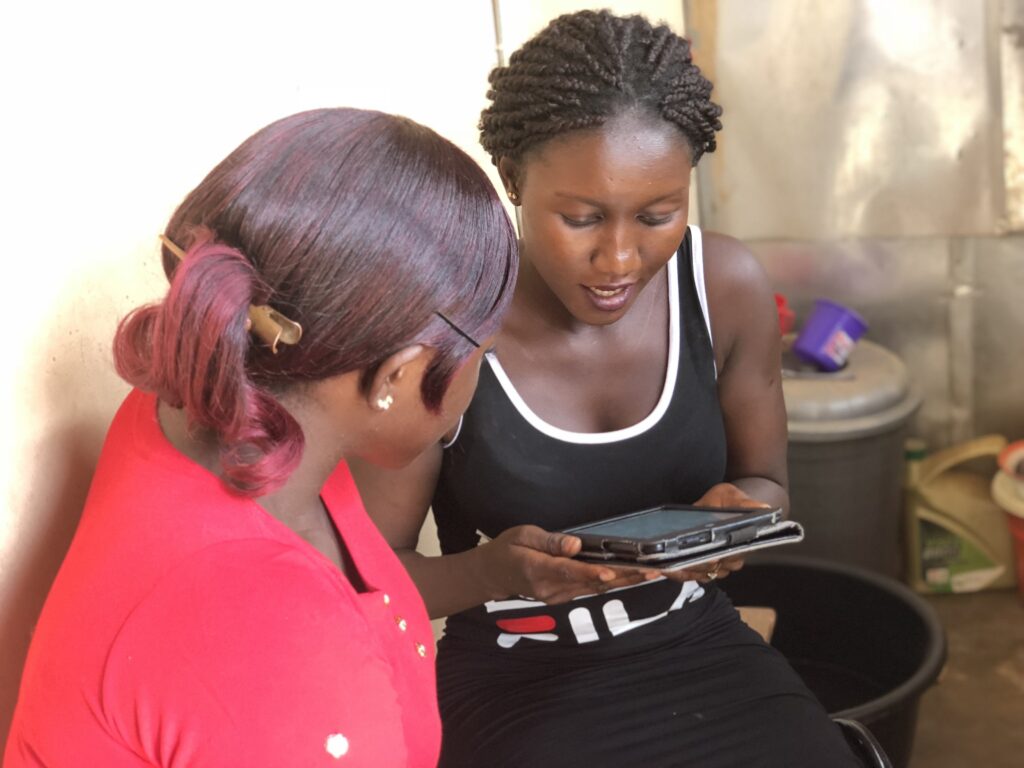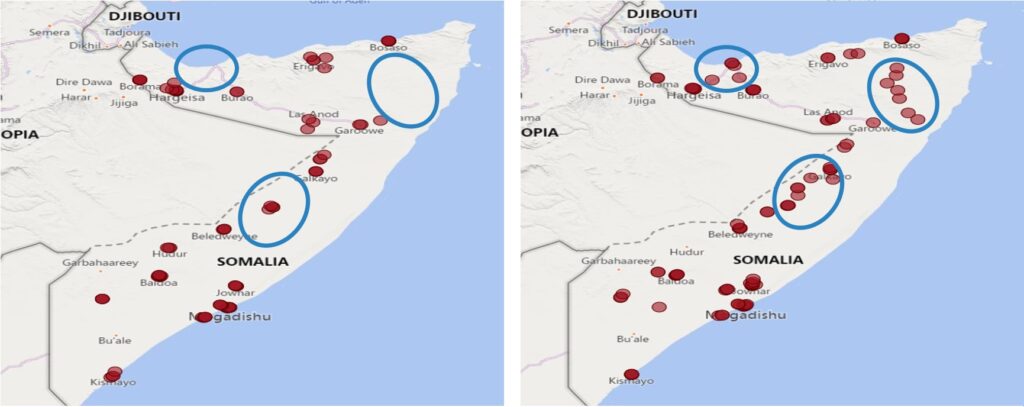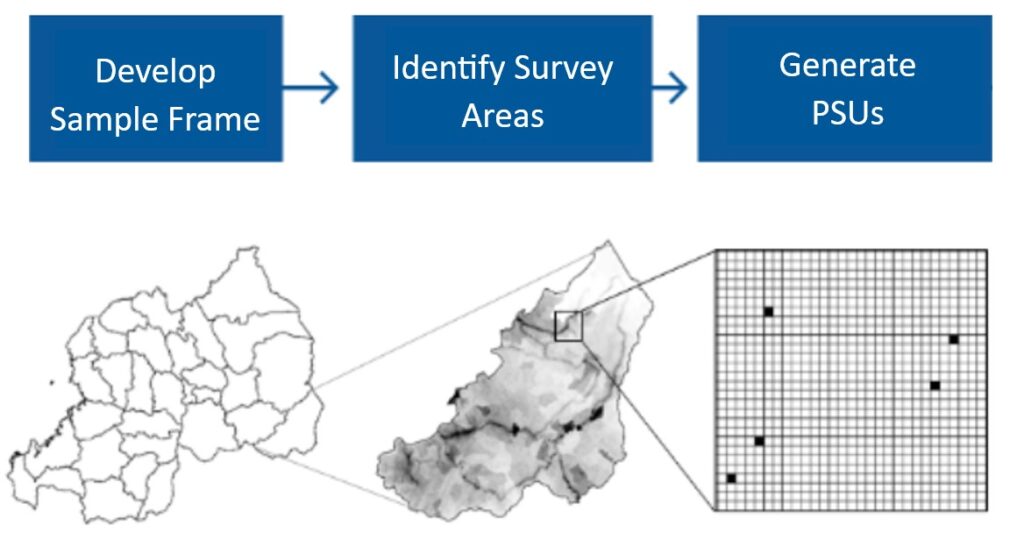
Image 1: ORB face-to-face interview
Since 2009, ORB has delivered multi-country, nationally representative, face-to-face surveys to many government agencies, development implementers, foundations and others. Many of these surveys take place in sub-Saharan Africa, which require innovative ways to collect data even in the best of times. Further, civil war, a global pandemic, military coups, and natural disasters have all complicated the settings in which ORB conducts research.
As a result, ORB has pushed to develop and refine high-quality, alternative tools to overcome data collection barriers in these regions. One of these tools is the gridded population sampling method. This tool allows us to draw a representative sample in volatile and migratory environments even without an updated census, which is common in these environments.
What is gridded population sampling?
Gridded population sampling is a method that uses population estimates to randomly select locations for inclusion into a sample. Unlike a census-based approach, which relies on a national count of every person in every household, gridded approaches rely on population estimates gathered from datasets that estimate populations. These datasets can include satellite imagery, human-verified geographic information (such as roads, night-time lights, and infrastructure), and other spatial data. These population estimates are then used to create a sample frame; a complete document cataloguing every residential village, town, or city in a given country.
Once the sample frame is created, ORB can adjust it to meet survey specifications, including meeting desired urbanity levels, restricting by specific administrative districts, or inputting custom boundary definitions. ORB then generates a random sample of geographic areas from the sample frame to include in the study. Called Primary Sampling Units (PSUs), these areas are the exact locations where ORB will conduct surveys. Since these PSUs are randomly selected from the whole sampling frame, they provide an accurate representation of the opinions of the entire country, given a sufficient number of interviews.
Image 1: Gridded Population Sampling process
When do you use gridded population sampling?
Gridded population sampling is most effective when a sampling frame is inaccessible, incomplete, or does not exist. Many of the countries we conduct research in have extremely outdated censuses (for example, Somalia hasn’t had a national census since 19871). Therefore, gridded population sampling has been a major asset to ORB.
By using gridded population sampling over census-based sampling, ORB can:
- Reflect more accurately growing urbanization rates. At the time of publication, nearly 1 in 5 low- and middle-income countries have not had a census in 15 years2. Because of the growing urbanization rate in many of these countries (in Burkina Faso, there was a 1.2% increase in urbanization levels from 2021 to 20223), most censuses often do not accurately reflect the current levels of urbanity. ORB uses gridded population sampling to solve this issue in Burkina Faso and other countries. The datasets used for this method are updated every 5 years to better capture changes in population settlements, thus reflecting more realistic urbanity levels.
- Increase representation for more remote communities. For example, Somalia has faced widespread conflict for over three decades, which has caused more than 3.8 million people to be internally displaced4. Many of these communities migrate to remote regions, which causes them to often be underrepresented in survey data. However, because gridded population sampling looks at the entirety of the country and does not rely on official census alone, these migratory communities are identified and included proportionally in the sample.

Image 2: right: Census Somalia Project, left: Gridded Population Sampling Somalia Project
- Make sample frames more accessible and reliable. It can be difficult and costly to gather a sample frame in countries that lack reliable data collection methods and infrastructure when a census is outdated. Even if these frames can be gathered, (such as from a more recent health survey, or from a survey provider) it is often hard to verify the process used to create it. This can lead to unintended variation between surveys when conducting research across multiple countries or multiple years because different processes can lead to different sampling frames. The process of gridded population sampling is well-documented and standardized, which reduces human error in creating sampling frames and drawing samples for surveys.
- Better verification of survey locations. ORB’s rigorous quality control process includes GPS verification, but verifying GPS location can be difficult when working in the remote Malian desert or in the packed neighborhoods of Dakar, Senegal. When using gridded population sampling, a set boundary with custom coordinates is created for each PSU. This helps local teams know exactly where they should be interviewing and allows for more accurate data verification. This can also reduce interviewer bias, as the provided boundaries allow for clear delineations between PSUs, instead of the more flexible ones of cities, towns, or villages.

Image 3: an example of set boundaries
Conclusion
ORB is now in the process of developing a new gridded population sampling tool with even more robust capabilities. This tool utilizes newer datasets that capture a broader spectrum of urbanity levels, exclude any non-verified communities, and generate more comprehensive sample frames. All of these features will increase the rigor and accuracy of our data collection methods as well as increase the locations in which gridded population sampling can be used. These improvements will better the findings and recommendations we provide to our clients. ORB looks forward to the possibilities gridded population sampling provides to social science research in the future.
______________________________________
1 2020 World Population and Housing Census Program | UNSD
2 2020 World Population and Housing Census Program | UNSD

